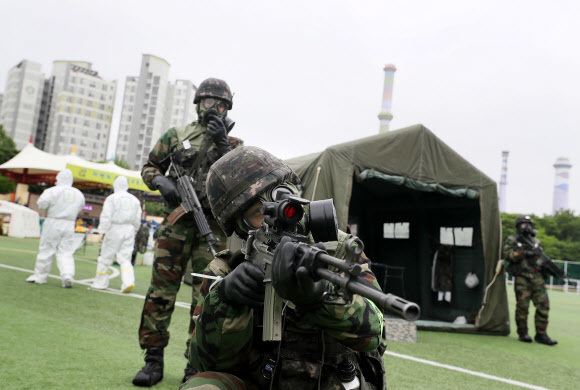 |
|
The South Korean military’s Ulchi Taegeuk Exercise, part of an effort to fulfill the required conditions for restoring wartime operational control to the South Korean military, takes place in Seoul’s Madeul Stadium on May 27. (Yonhap news)
|
Assessment of initial operational capability to take place in August
The exercises designed to assess the initial operational capability (IOC) of the South Korean military, which is the first step in checking the conditions for giving Seoul back wartime operational control (OPCON) of its military, will be supervised by a general in the South Korean military, sources said on May 28. This appears to deliberately reflect the structure of the future joint command, which will be led by a South Korean general. The IOC assessment is scheduled to take place in August alongside joint command post exercises by the South Korean and US militaries. The IOC assessment will reportedly concentrate on assessing the appropriateness of the organization and operation of the future military command, the ability to carry out critical missions for the combined forces, and the organization and operation of the air force component military command and the navy component military command, which are led by generals in the US military. The results of the assessment will be presented in the ROK-US Military Committee Meeting this October. If things go as planned OPCON transfer may take place during Moon’s presidency The assessment of the OPCON transfer proceeds in stages, beginning with the IOC assessment and continuing with an assessment of full operational capability (FOC) and full mission capability (FMC). If the South Korean military’s capabilities are demonstrated in the IOC assessment, experts believe, it should be possible for the OPCON transfer to take place before the end of Moon Jae-in’s presidency, with the FOC assessment taking place in 2020 and the FMC assessment in 2021. The South Korean and US militaries have been working to speed up the OPCON transfer, launching the Special Permanent Military Committee (SPMC) this year to regularly assess the conditions for the transfer. When the OPCON transfer is complete, the two armies will transition to the future command structure, in which a South Korean general serves as commander of the joint command and the US general who commands US Forces Korea (the current commander of the joint command) serves as vice commander. The South Korean military is reviewing the options of having the chair of the Joint Chiefs of Staff also lead the future joint command or of having another general fill this role. Given the duties currently held by the chair of the Joint Chiefs of Staff, sources say that the prevailing view is that it would be onerous for this individual to also take on the responsibilities of heading up the future joint command. By Yoo Kang-moon, senior staff writer Please direct comments or questions to [english@hani.co.kr]






